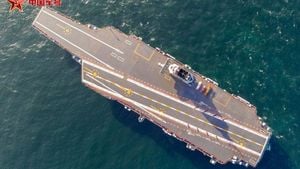China’s ambitious military expansion in the South China Sea continues to raise eyebrows and concerns among neighboring countries and global powers alike. Over the past two decades, Beijing has transformed vast areas, converting fields and ports along its coastline and on reclaimed reefs, particularly around Hainan Island, to house modern military installations. This extensive rebuild and upgrade, costing around $50 billion, aims not just at regional sovereignty, but plays deeply ambitious global aspirations of power projection.
The South China Sea is of significant importance as it forms one of the world’s busiest maritime routes, with about one-third of global maritime trade passing through its waters. This route is not only pivotal for trade but also serves as the conduit for energy supplies to China, which increasingly depends on oil and gas from the region. China's push to establish military dominance over these waters can be interpreted as part and parcel of its wider strategy to secure these key maritime logistics against perceived threats, primarily the United States and its allies.
Experts have analyzed satellite imagery and military data, highlighting how the People's Liberation Army (PLA) has tripled the infrastructure’s value on Hainan and surrounding territories. According to the Long Term Strategy Group, which consulted with the Defense Department for its recent report, this extensive development includes building new bases and upgrading outdated ones to host advanced weaponry, surveillance systems, and aircraft.
Vietnam, standing right at the heart of these territorial tensions, has voiced serious grievances over China’s actions. The country’s foreign ministry recently announced Vietnam's protest against the alleged detention of its fishermen and vessels by Chinese authorities near the contested Paracel Islands, which both Vietnam and China claim as their territory. “We urge China to immediately release the fishermen and fishing vessels illegally detained,” the spokesperson declared, emphasizing the challenges of enforcing maritime regulations amid rising pressures.
These skirmishes aren’t simply about fishing rights; they reflect the broader geopolitical struggle for dominance over contested waters rich with resources. The tension between Beijing’s naval assertiveness and the United States' strategic pivot toward Asia is glaring. The U.S. has repeatedly stated its intention to challenge Chinese claims and support allied nations like Vietnam and the Philippines, reinforcing maritime rules and freedom of navigation principles.
China’s historical claim is rooted deep, often traced back to the Nine-Dash Line, which outlines its asserted territorial waters. Countries like Vietnam and the Philippines contest this claim, seeing it as encroachment on their own rights and waters. The geopolitical consequences of this clash create ripples across international diplomacy, as nations are pressed to respond to China's expansion without igniting conflict.
China’s military development is not merely about fortifying its maritime borders; it's also about acquiring technological superiority and capabilities to counteract U.S. military presence. Analyst assessments reveal this trend includes advanced electronic surveillance, anti-access/area denial systems, and longer-range reach for naval operations. These initiatives are perceived not just as defensive measures but as strategic moves aiming to deter any hostile actions against China’s territorial aspirations, particularly concerning Taiwan, which Beijing sees as its territory.
Interestingly, this arms race scenario has prompted other regional players to bolster their own military capabilities. Nations like Japan, Australia, and India have entered cooperative defense pacts, aiming to create counterbalancing measures against China’s rising influence. The Quadrilateral Security Dialogue, involving the U.S., India, Japan, and Australia, stands as one such effort to curtail Beijing’s assertiveness by promoting interoperability and joint military exercises.
Returning to Vietnam, analysts note how the detentions of fishermen paint broader patterns of Chinese exertion of control. The government’s dissatisfaction reveals the urgency and fragility of local fishing communities who depend on these waters for their livelihoods. Vietnam's entreaties for diplomatic dialogue over aggressive stances exemplify the need to resolve such disputes to avoid escalation.
On the international stage, the South China Sea issue is non-trivial and has drawn responses from multiple global organizations, including the United Nations. Calls for adhering to international law and negotiations on the Code of Conduct within the region have been continuously emphasized. Yet, results from these summits often seem stagnant due to the complexity of claims and the unwillingness of Beijing to publicly concede territorial rights.
While China’s military buildup is undoubtedly impressive, experts caution against viewing it as invulnerable. The logistical challenge of sustaining extensive operations over such vast, often hostile waters presents limits to their strategic flexibility. There are concerns, too, about the ramifications of miscalculation, which could easily escalate from military exchanges to broader conflicts.
Reflecting wider global dynamics, China's militarization of the South China Sea spotlights not just regional tensions but highlights the significant shifts occurring on the world stage. The interplay of power among nations continues to evolve, with Asia at the forefront of contemporary geopolitical fraughtness.
While the world watches, Vietnam's calls for China to release its detained fishermen underline the precariousness of sovereignty and rights within these waters, reminding us all of the urgent need for diplomacy over escalation. With tensions simmering, the future of the South China Sea remains uncertain but undeniably pivotal.



